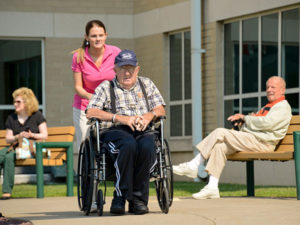
Staffing is perhaps the most important factor in a nursing home resident’s quality of care and the ability to live with dignity. Unfortunately, inadequate nursing home staffing is a widespread and persistent problem. Some nursing homes provide proper care, ensuring that their facilities have enough qualified care staff. However, many nursing homes still fail to maintain safe and sufficient staffing.
You can get staffing information from CMS’ payroll-based journal data, but there’s another tool that makes it pretty simple for reporters and consumers to find out whether nursing homes in their state meet requirements.
Every quarter, the Long Term Care Community Coalition publishes staffing information for every nursing home in the country. They recently released stats for 2Q 2019, the most recent period reported by CMS. LTCCC is a New York state-based consortium of consumer, community, civic and professional organizations that focuses on systemic issues that affect the quality of care and dignity in long-term care.
I found the site’s design and layout more user-friendly than Medicare’s Nursing Home Compare. For example, there are charts for every state that include the following for each facility in compliance with the reporting requirement:
- The facility’s resident census (population)
- Its direct care R.N., L.P.N., and C.N.A. staffing levels
- The amount of care staff hours per resident per day for both all care staff and for registered nurses specifically
- Select non-nursing staff hours per day, including administrators, social workers, and activities staff
And unlike NHC, you can look at information for more than three facilities at a time on LTCCC’s tool.
Many nurses say staffing ratios are dangerously unsafe, according to this story at Nurse.org. However, staffing can be defined using different criteria. LTCCC points out that CMS includes nurses assigned to non-care functions in their computations of staffing levels; but they only count staff which the nursing homes have designated as providing resident care in these data sets.
Files are easily sortable, so consumers (and journalists) can answer important questions like which facilities in the state have the highest and lowest reported levels of RN care. Downloadable Excel files can easily be imported into Tableau or other visualization software, like this interactive map, showing total and RN staffing hours per resident day, by state. For example, in Texas and several other states, RN staffing is at 0.2 hours per resident day. Compare that to Washington state or Maine, at 0.7 hours, or Wyoming, at 1.0. It would be interesting to compare this data to a similar interactive staffing map from Kaiser Health News.
Is it a workforce shortage, poor management, or another issue that keeps RN staffing so low in some states? Is this why one Texas home — with sexual assault allegations — is among the most fined facility in the U.S.? Are these lower-ranking homes among CMS’ special focus facilities? If not, why not?
How are states addressing this serious problem? This story in the Chicago Tribune reports on Illinois’ recently passed legislation, which imposes hefty fines for understaffing. What is your state doing?
There’s a wealth of stories to be found in this data. Combined with a tool like ProPublica’s Nursing Home Inspect, reporters can take a deep dive into the most troubled facilities, and which ones are doing a good job of caring for vulnerable elderly.
Additional reading
- New rules for nursing home staffing in California, from the National Association of Nursing Home Attorneys
- This Dayton Daily News story investigates why so many nursing homes’ ratings fell after CMS revised its method for evaluating staffing.
- The Pennsylvania Capital Star reports that the state is facing a crisis shortage of nursing home staff and is unprepared for the wave of aging baby boomers.
Federal legislation to watch
- S2943: The Quality Care for Nursing Home Residents Act would revise minimum nurse staffing requirements for skilled nursing facilities under the Medicare program and nursing facilities under the Medicaid program. Introduced by Sen. Richard Blumenthal (D-Conn.)
- 2993: Ensuring Seniors Access to Quality Care Act would provide nursing home operators with access to the National Practitioner Data Bank (NPDB), an existing national criminal background check system. It also would amend regulations that bar certain senior living facilities from conducting training programs for in-house Certified Nurse Assistants. Co-sponsored by Sen. Mark Warren’s (D-Virginia) and Sen Tim Scott (R-South Carolina)
- R. 4468; the Nursing Home Workforce Quality Act would allow nursing homes forced to suspend in-house CNA education programs after receiving a certain level of penalties to resume those programs once they meet quality standards. Co-sponsors are Rep. Dwight Evans (D-Penn.-03), and Senator Ron Estes (R-Kansas)








